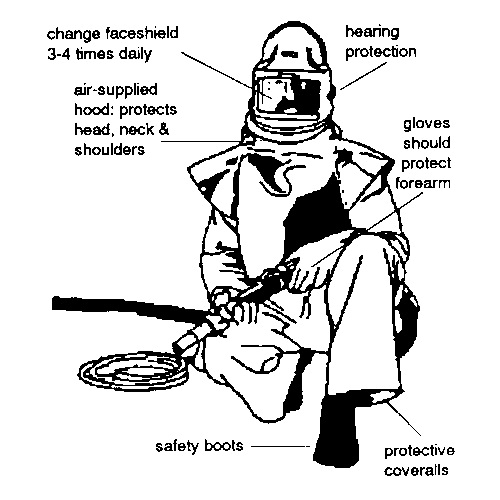Tips for Sandblasting House Paintings
Sandblasting a house removes old paint down to the bare wood. It is easier than scraping or using a rotary sander, but it is messy. A sandblaster uses pressurized, compressed air to blast sand through a nozzle and onto the house paint. The blasted sand rubs away the old paint and dirt from the wood's surface, leaving it like new and restoring the wood's natural beauty.
Breathing Apparatus
Protection is necessary when working with a sandblaster. Airborne dust and fine sand pose serious respiratory hazards in lungs and airways. Wear a respirator with a clean air supply. Avoid using silica sand because of the dangers of contracting the lung disease, silicosis.
Protective Equipment
Wear protective outerwear when sandblasting to prevent skin irritation. Heavy canvas or leather coveralls inhibits skin exposure to the blasted sand. Tuck the pant legs securely into heavy work boots and tie off sleeves to minimize sand exposure. Wearing full arm, heavy rubber or leather work gloves protects the hands from the highly pressurized flow of sand. Provide noise reducing earplugs or headsets to anyone near the work area because the sandblasting equipment is very loud. Wear a full-faced helmet when in the sandblasting zone.
Sandblasting Zone
Diminish environmental hazards and prevent toxic dust from polluting the surrounding area by placing a leak-proof tarp around the work zone at least 9 feet above, below and to the sides. Avoid sandblasting on windy days because microscopic sand particles become airborne.
Lead
Most house paint used before 1970 contained lead. If lead is present, safety precautions are necessary to protect people and the environment from exposure to lead poisoning. The U.S. Environmental Protection Agency issued regulations for safety when working with lead paint, stating that workers require EPA certification in lead contamination procedures.
Equipment Check
Check all the hoses, clamps, nozzles and fitting for loose parts or leaks. Replace any worn parts before using the sandblaster. Make sure all the valves work correctly before adding sand to the blaster. Operate the sandblaster at 15 pounds per square inch, or PSI, or less and depressurize the unit before leaving the work area for any reason.
Tags: Feng Blast News


